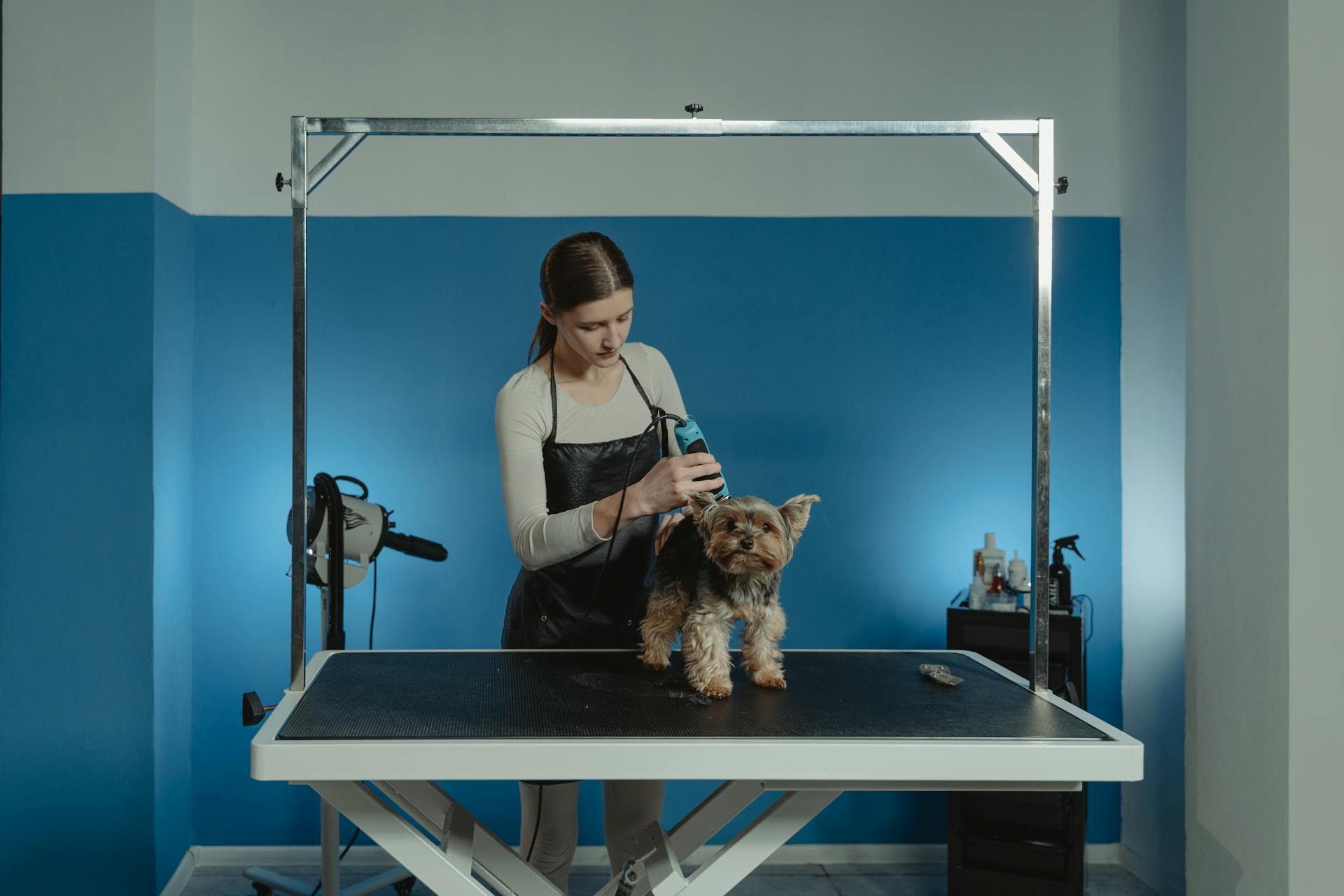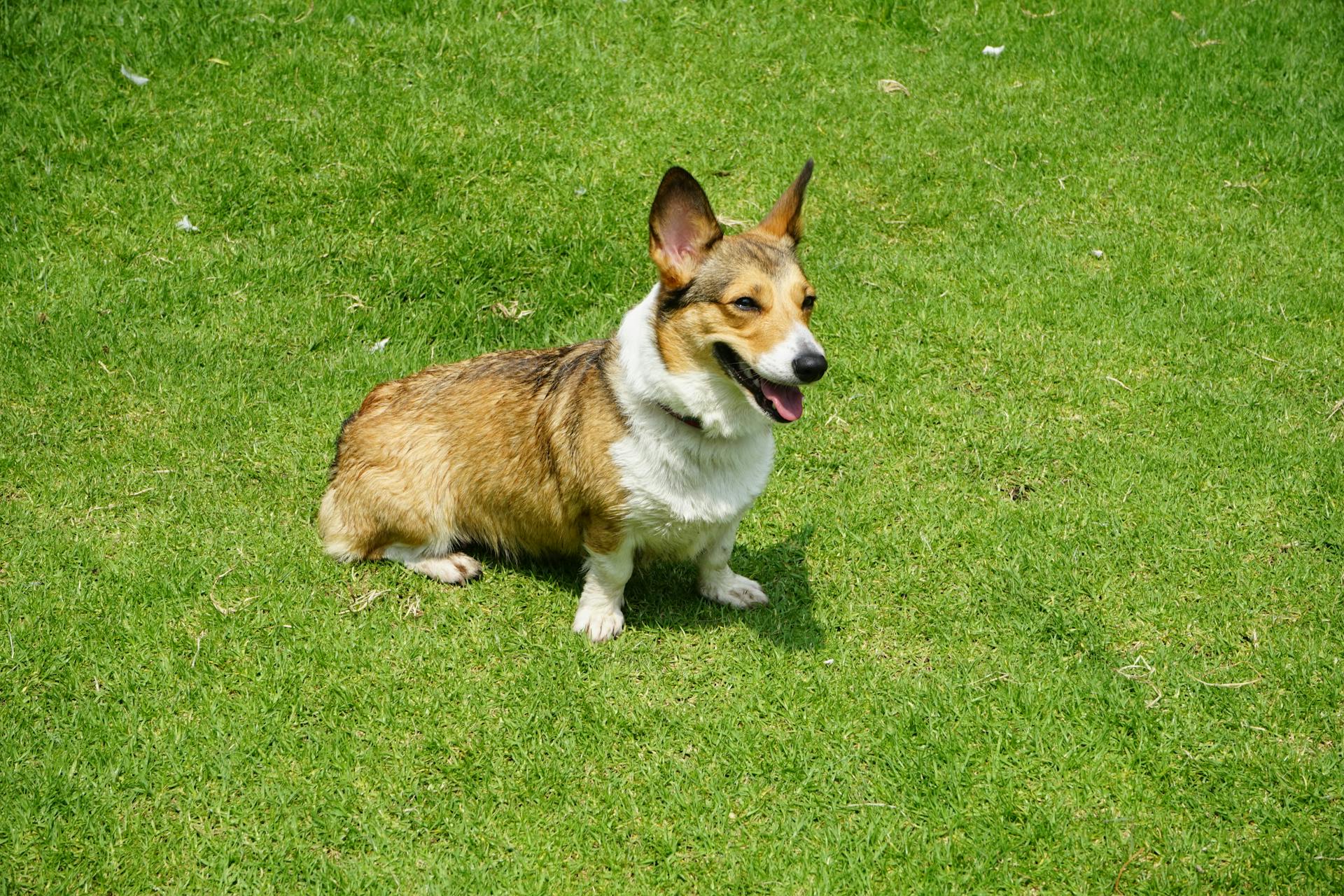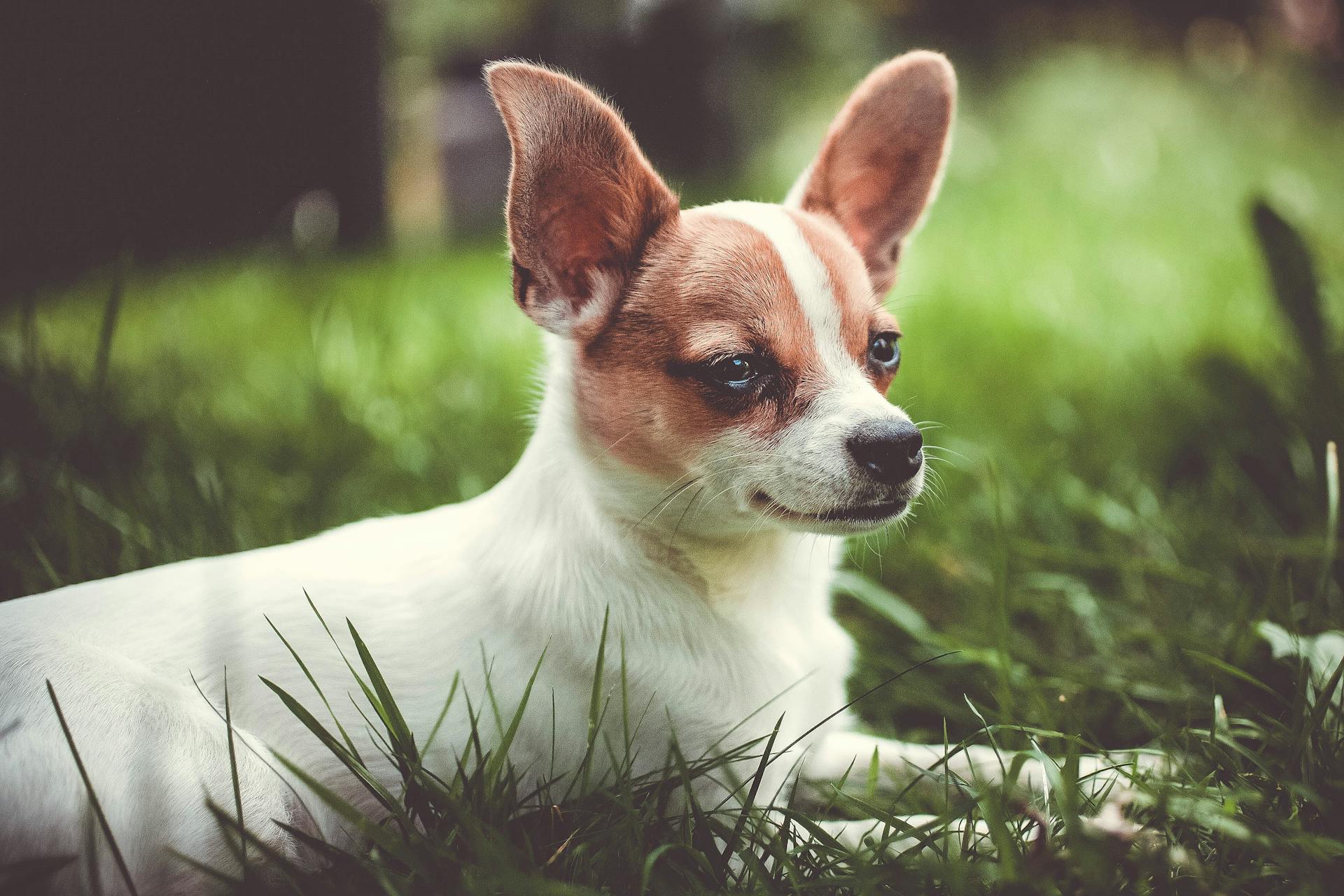
The Scottie Dog Mix is a charming breed that's gained popularity in recent years, and for good reason. They're loyal, intelligent, and full of energy.
Scottie Dog Mixes are a cross between a Scottish Terrier and another breed, which can affect their size and weight. They typically weigh between 18-40 pounds.
With their short coats, Scottie Dog Mixes require regular grooming to prevent matting and tangling. Brushing them 2-3 times a week is a good starting point.
Their exercise needs are moderate to high, requiring daily walks and playtime to keep them happy and healthy.
Quick Facts
Scoodles are a relatively new mixed breed, developed in the United States in the 1990s as a cross between the Scottish Terrier and the Poodle.
They're medium-sized dogs, typically weighing between 10 and 20 pounds, with a square-shaped body and a long, wiry coat that can be straight or curly.
You can expect to see them in a variety of colors, including black, brown, white, cream, and gray.
Scoodles are intelligent, playful, and affectionate dogs that are good with children and other pets. However, they can be stubborn at times and may require some extra patience during training.
Regular grooming is essential to keep their coat healthy and free of mats. They should be brushed at least once a week, and their coat may need to be trimmed more often.
To keep your Scoodle happy and healthy, aim for at least 30 minutes of exercise per day. They love playing fetch, going for walks, and running around.
Here are some key characteristics to keep in mind:
- Weight: 10-20 pounds
- Size: Medium-sized dogs
- Coat: Long, wiry coat that can be straight or curly
- Colors: Black, brown, white, cream, and gray
- Exercise needs: At least 30 minutes per day
- Grooming needs: Regular brushing and trimming
All-Around Friendliness
Scottie dog mixes can make wonderful companions, but it's essential to understand their temperament to ensure a harmonious relationship.
They thrive on praise and will do anything to see a smile on your face, as long as you're consistent with positive training methods.
Scoodles are highly intelligent and understand everything you say, which can sometimes make them seem stubborn due to their independent nature.
A properly socialised Scottish Doodle can get along well with children and other dogs, but without socialisation, they can be quite grumpy toward other house pets.
They're not naturally trusting of strangers, so early socialization is crucial for getting them used to visitors and other dogs.
Scottie mixes are highly territorial dogs that love to patrol the house both inside and out, which might lead to barking at intruders.
Their high prey drive means cats are likely to be problematic, but if introduced correctly at a young age, they can live well with feline friends.
Scoodles are happy to spend time alone and can benefit from crate training from an early age to aid in housetraining and provide a safe space for some "me time".
Health and Needs
Scottie dogs are a fantastically healthy breed, with a long history that has helped solidify their robust health.
Scotties are prone to some minor concerns, such as von Willebrand's disease, craniomandibular osteopathy, and patellar luxation. These issues are relatively rare, but it's essential to be aware of them.
Scottie cramp is another minor affliction that can affect some dogs, causing spasms in their back and hindquarter muscles during periods of high excitement or physical activity.
Health Needs

Scottish Terriers are a fantastically healthy breed, thanks to their long breed history.
The most common health problems in Scottish Terriers include von Willebrand's disease, a disorder that can affect clotting.
Craniomandibular osteopathy, an enlargement of bones in the head, is another common issue.
Patellar luxation, a condition where kneecaps are loose, can also affect Scottish Terriers.
Scottie cramp, a tendency for some dogs to suffer spasms in their back and hindquarter muscles, is a minor concern.
It's recommended to get your Scottish Terrier screened for basic cancers, which can be hereditary in the breed.
These cancers include bone cancer, lymph-node cancer, mast-cell tumors (skin cancers), and oral cancer.
Living Needs
Scotties are adaptable dogs that can thrive in apartment living, making them a great fit for city dwellers.
They love to play and go on walks, and they're happy to entertain themselves in the house.
However, a rambunctious Scottie might not be suitable for households with toddlers or small children, as they require supervision and proper interaction.

They're headstrong and independent dogs, which means they can be a handful at times.
If you have a yard, be prepared for some digging, as Scotties have a strong prey drive and will chase small animals like squirrels.
Fences are a must-have to keep them contained, and be prepared to talk them out of digging if you want to save your yard.
Overview and History
The Scoodle, a charming hybrid breed, is the result of crossing a Scottish Terrier (Scottie) with a Poodle. This breed combines the distinct characteristics of its parent breeds to create a delightful companion dog.
Scoodles typically inherit the intelligence and low-shedding coat of the Poodle, making them an excellent choice for families with allergies. They are small to medium-sized dogs with a sturdy build, a moderately long coat, and a distinctive beard, often resembling a mini-Scottie.
The Scottish Terrier, one of the oldest breeds in the world, is known for its smarts and independent streak. They require patience and consistency to train, but with early socialization, they'll fit in well with other family dogs.
Here's a brief overview of the Scottish Terrier's characteristics:
The Scottish Terrier's history is not clear, but the earliest mention of a dog matching the Scottie's description can be found in the book titled The History of Scotland 1436-1561.
Overview
The Scottish Terrier is a small, energetic dog breed that's perfect for families with older children or seniors. They're highly intelligent, but can be stubborn at times.
Scottish Terriers typically weigh between 18 to 22 pounds and stand 10 to 10 inches tall. They have a long, wiry coat that requires regular grooming.
These dogs are known for their friendly and playful personalities, but they can also be willful at times. Early socialization is key to helping them fit in well with other family dogs.
Scottish Terriers are generally good with dogs, families, and seniors, but their strong prey drive means they may not get along with cats. They require high energy levels and regular exercise to stay happy and healthy.
Here are some key traits of the Scottish Terrier breed:
Scottish Terriers are adaptable to different living environments, including apartments, as long as they receive regular exercise and mental stimulation.
History of

The Scottish Terrier has a rich history that spans centuries. The breed originated in the Scottish Highlands, where they worked as hunters and farm dogs.
Their exact origin is unclear, but it's believed to be the oldest of the Highland terriers. Breeders worked to standardize the different types of terriers from Scotland during the late 1800s, resulting in the Scottie, Skye terrier, West Highland white terrier, and cairn terrier.
The Scottie arrived in the United States in 1883 and was recognized by the American Kennel Club in 1885. Their popularity peaked in the 1930s and '40s, with many public figures owning Scotties, including President Franklin D. Roosevelt.
King James VI of Scotland and King James the First of England promoted the breeding of Scottish Terriers, which helped establish the breed.
Here's an interesting read: Cavalier King Charles Spaniel Cross Yorkshire Terrier
Grooming and Care
Grooming a Scottie dog mix requires regular attention to prevent mats and tangles.
Their coat demands a considerable amount of grooming, often frustrating dog parents. Regularly checking their ears, which are full of thick hair, is essential to prevent dirt or wax buildups. Brushing this breed three to four times a week is ideal to manage shedding and prevent mats.
A Scottie's coat doesn't shed much, but it does grow continuously and requires specialized care. Hand-stripping at least once a month or clipping roughly every six to eight weeks is necessary to maintain their coat's proper harsh texture.
In between grooming sessions, brush the coat at least weekly to remove any tangles and dirt. Giving your dog a bath every month or so, depending on how dirty they get, is also essential.
Their coarse, wiry topcoat will need to be brushed two or three times a week to keep it straight and tangle-free. Additionally, their thick, soft undercoat will need to be treated regularly, preferably through hand-stripping.
Like all dogs, a Scottie dog mix needs their nails kept tidy and trim, their ears should be checked and cleaned regularly, and they need a regular dental care routine.
Size and Appearance
Scoodles are small dainty dogs, but their height and weight are not standard. They can grow between 8-14 inches at the shoulders and weigh around 9-20 pounds.
Their appearance can vary greatly, with some Scoodles having a double coat like their Scottie parent, while others inherit the Poodle's curly coat with a wide range of colors.
Scoodles often have short legs like the Scottish Terrier, and despite their short stature, they have powerful hind legs that can dig.
A Scoodle's coat can be wiry and dense with a soft undercoat, or it can be curly and come in a variety of colors, including apricot, white, black, brown, tan, grey, silver, and cream.
Some Scoodles may take after their Scottish Terrier parent and display less curls and a more wiry texture in their coat, while others may have a thick and curly-haired coat with adorable floppy, curly-haired ears.
Their height is not as consistent as their Scottish Terrier parent, with some Scoodles growing to be around 10 inches tall, while others may be shorter or taller.
For your interest: Short Haired Border Collie Terrier Mix
Dog Nutrition
Always provide fresh water for your Scottie dog mix.

Fresh water is essential for your pet's overall health and well-being.
Feed a high-quality, nutritionally balanced canine diet, and discuss the amount of food and type of diet with your vet to ensure you're meeting your dog's individual needs.
Be mindful of treats and other extra food to prevent overfeeding and subsequent weight gain.
In the first few days after bringing your pet home, stick to the food the breeder was feeding it, and later switch to dog food as recommended by your vet nutritionist.
Always make dietary changes gradually to prevent digestive upsets.
You can choose from kibble, canned/wet food, freeze-dried food, or raw food, but always check your vet's recommendations regarding the best type of dog food for your Scottie dog mix.
Obesity is a concern for these small dogs, so monitor your pet's food portions and ensure it exercises daily.
Keep treats to a minimum – no more than 5 to 10% of your pet's total calorie intake daily.
For another approach, see: Mix Dog Food Brands
Allergies and Skin Issues
Scottie dog mixes, like Scoodles, can be a great choice for people with allergies because they have hypoallergenic coats that shed minimally.
Their water-resistant coats are a result of inheriting low-shedding traits from both parent breeds, the Scottish Terrier and the Poodle.
However, it's essential to be aware that Scoodles can still develop skin issues if they have food or environmental allergies, or if they're infested with parasites that cause itchy rashes on their bellies.
If you're considering bringing a Scottie dog mix into your home, be prepared to research and take steps to prevent allergies and skin issues, such as choosing a balanced diet and keeping their environment clean.
Are Hypoallergenic?
Scottish Doodles have a hypoallergenic coat due to their parent breeds' low-shedding characteristics. The Scottie's water-resistant coat sheds minimally, and the Poodle's coat is also water-resistant and low-shedding.
Some dog breeds are naturally better suited for households with allergy sufferers. A Scottie has a water-resistant coat that sheds minimally.
The Scoodle's low-shedding coat makes it a great option for families with allergies.
On a similar theme: Poodle Portuguese Water Dog
Dog Itchy Rash on Belly
Dog itchy rash on the belly area could be caused by food or environmental allergies, parasites. If your dog is experiencing an itchy rash, it's essential to identify the underlying cause to provide the right treatment.
Parasites like fleas, ticks, and mites can cause intense itching and skin irritation. These pesky critters can be found in your dog's belly area, making it a common spot for itchy rashes.
Food allergies can also lead to itchy rashes on your dog's belly. Common culprits include beef, dairy, and wheat, which can cause skin irritation in some dogs.
Cost and Ownership
If you're considering bringing a Scottie dog mix into your family, be prepared for a significant financial commitment. The initial cost of a Scoodle puppy from a responsible breeder can range from $1000 to $3000.
You'll also need to factor in ongoing expenses, such as veterinary care, which can add up quickly. Medical/veterinary costs can be a significant portion of the estimated $13,000 to $20,000 you'll need to budget for your dog's lifetime expenses.
Additionally, you'll want to consider pet insurance, food, treats, grooming, and training costs, which can vary depending on your dog's age, coat color, and other factors.
How Much is It?

The cost of owning a Scoodle can be significant, but it's essential to understand what you're getting into. The initial price of a Scoodle puppy from a responsible breeder can range from $1000 to $3000.
You'll also need to consider the costs associated with dog ownership. Medical and veterinary expenses, pet insurance, food, treats, grooming, and training costs can add up quickly.
Be prepared to shell out at least $13,000 to $20,000 over your dog's lifetime. This includes not just the initial purchase price, but all the ongoing expenses that come with caring for a furry friend.
Prospective Owners
So, you're thinking of getting a dog? First, you need to choose your breed. This will determine the size, energy level, and grooming needs of your new furry friend.
Choosing the right breed is crucial because it affects how much exercise and training your dog needs. For example, some breeds require daily runs, while others are happy with short walks.

Next, consider why you want a dog. Is it for companionship, exercise, or to teach your kids responsibility? Whatever your reason, having a dog can bring immense joy and benefits to your life.
Finding a responsible breeder is essential to ensure you're getting a healthy puppy. Look for breeders who health test their breeding stock and prioritize the well-being of their dogs.
If you're interested in dog sports, consider breeds that excel in agility, obedience, or herding. This can be a great way to bond with your dog and get exercise together.
Puppies require a lot of attention and care, so make sure you're ready for the commitment. All About Puppies provides valuable information on what to expect during the first few months with your new dog.
Check this out: Golden Retriever and Yellow Lab Mix Puppies
Frequently Asked Questions
What is the temperament of a Scottish Terrier mix?
Scottish Terrier mixes are known for their feisty and independent nature, which can sometimes manifest as moodiness and stubbornness in adulthood. They may also be selective about who they bond with and can be challenging to train due to their strong will.
Are Scotties good family dogs?
Scottish Terriers can make great family pets, but they're best suited for families with older children who have experience with dogs
What is a Westie Scottie mix called?
A Westie Scottie mix is commonly known as a Scotland Terrier. This unique breed combines the characteristics of the Scottish Terrier and the West Highland White Terrier.
Sources
- https://dogtime.com/dog-breeds/scoodle
- https://www.akc.org/dog-breeds/west-highland-white-terrier/
- https://www.thesprucepets.com/scottish-terrier-dog-breed-profile-4782421
- https://raggydogs.com.au/blog/%EF%BF%BCscoodle-complete-guide-to-the-scottish-terrier-cross-poodle-mix-breed/
- https://www.dailypaws.com/dogs-puppies/dog-breeds/scottish-terrier
Featured Images: pexels.com


